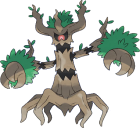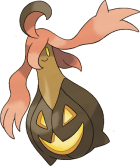(I also wonder if giving you a signpost in this way was related in any way to Game Freak's reasoning that "it would be too complicated" to release the Azure Flute, but maybe not)
This comment in the “little things you like” thread got me thinking again about a post I’d been meaning to make regarding the whole Azure Flute controversy, summarizing some insights that I picked up a few years ago from a Twitter user by the name of AdeptCharon, and combining them with some of my own thoughts.
Fans have dogged on Junichi Masuda’s answer for why the Flute was never distributed for over a decade now, because it does seem rather silly on the face of it — what’s so complicated about getting the Flute and going to Mt. Coronet, especially when that’s essentially how all of the previous Mythical events had worked? It’s even more baffling in light of several of the series’s other convoluted encounter methods, such as Feebas, Spiritomb, and the Regi trio.
But… there are some layers of historical context here that are worth considering.
The first being that this particular quote from Masuda comes from an interview
posted by Nintendo World Report in September 2013, in the lead-up to X & Y’s release. For the sake of being comprehensive, the exact exchange is as follows:
>
NWR: How come the Azure Flute was never made available in Diamond/Pearl/Platinum?
>
JM: When we were first developing the games we thought about including it. I thought it would be fun. But once the game was complete and released, I changed my mind down the road and didn’t think it would be – I thought it would be confusing for people and kind of hard to understand how it worked. So I eventually made the decision not to distribute it.
Now, the thing that has always stood out to me is, this interview is mostly about X & Y, because those were the most recent upcoming games at the time. The inquiry about the Azure Flute is just a point of general curiosity thrown in toward the end. So, given that the subject of the interview was clearly meant to be the imminent release of X & Y, not random bits of cutting room floor trivia, I would not entirely discount the possibility that Masuda simply threw out a very broad answer to an unusually niche, off-topic question that he likely wouldn’t have expected to be asked.
But even if that wasn’t the case, there is still a more important bit of history to remember. Recall how I said, “that’s how all of the previous Mythical events had worked.” The thing is… that’s not
entirely accurate.
Sure, in FRLG and Emerald, we had events that required the player to download a special item, which they would then take to one of the ship docks in order to receive passage to a hidden area where they could battle and capture the Mythical Pokémon.
Diamond & Pearl contained similar programming infrastructure for three such Pokémon: Darkrai (using the Member Card), Shaymin (using Oak’s Letter), and Arceus (using the Azure Flute). And we know that Darkrai and Shaymin got their respective events, so why not Arceus?
The answer? Because Diamond & Pearl were broke as fuck, lmao.
It’s fairly well-known by now that Diamond & Pearl have quite a few significant glitches. One in particular, the
surf glitch, actually makes it possible for players to travel to Newmoon Island and the Flower Paradise, where they can then capture Darkrai and Shaymin without ever receiving the Member Card or Oak’s Letter. And if you were to obtain those items later, after catching those Pokémon illegitimately, the Pokémon themselves would not respawn, making it so that the item you downloaded does not work as advertised. This is even more important to note in the context of Japanese events, which had come to act as tie-in events for upcoming animated films. The way it worked in Japan (and this was back when the Japanese versions of the games also released months in advance of the worldwide versions, so Japanese players were also the first to experience these events) was, you would buy a ticket to go see the movie, and at the cinema, you would be able to download the event Pokémon or item.
As an apparent result of this issue, Darkrai and Shaymin
weren’t ever distributed for Diamond & Pearl via the intended method. All distributions of those two for Diamond & Pearl were a direct pick-up at a Pokémon Center, instead of receiving the Member Card or Oak’s Letter and then traveling to the corresponding location. That way, anyone who purchased a ticket to see those films would still be able to receive the tie-in promotion that had been advertised, even if they had exploited the glitch to obtain Darkrai and Shaymin prematurely.
It wasn’t until the release of Platinum, which fixed the surf glitch (at least insofar as making it so that those Pokémon wouldn’t spawn without the player owning their corresponding event items), that the Member Card and Oak’s Letter were released. Which makes sense — Darkrai and Shaymin had already been made available through previous events for Diamond & Pearl, and with that glitch patched, Game Freak and the Pokémon Company could now rest assured that players downloading the Member Card or Oak’s Letter would not run into the potential problem of participating in an event in which the intended experience may have been undermined by a glitch.
That leads us to Arceus, and the Azure Flute. Arceus was finally distributed after the release of HeartGold & SoulSilver, as a tie-in promotion for the film
Arceus and the Jewel of Life. By this point, Diamond & Pearl were still the Generation 4 games with the largest install base, and unlike Darkrai and Shaymin, Arceus hadn’t been released for Diamond & Pearl prior to this distribution. This was the first time that anybody would have been able to get their hands on one legitimately.
But here’s the rub: By now, Diamond & Pearl players had been trained to understand Mythical event distributions a certain way — they buy a movie ticket, they go to the theater, they download the Pokémon, and pick it up at the Pokémon Center. While Platinum players may have been able to experience the Member Card and Oak’s Letter events as intended, they were not the majority.
So now, for the first distribution of Arceus, it seems probable that instead of hosting two separate events for the two different games (which might have been deemed confusing for players, particularly younger ones, and perhaps needlessly complicated on a technical end for the distribution partners), and instead of having the event work contrary to what Diamond & Pearl players had grown accustomed to (by having to download an item and then take it to Mt. Coronet, instead of just picking the Pokémon up at the Pokémon Center), Game Freak and/or the Pokémon Company decided to standardize the distribution for all players, by foregoing the Azure Flute step and simply distributing the Arceus directly. After all, the Pokémon itself is really the focus of the event, more than the steps to obtain it, so it’s not as if bypassing the Hall of Origin encounter is a huge loss in the grand scheme of things.
I think it’s entirely possible — even quite likely — that
this is the sort of problem that Masuda was alluding to when explaining why the Flute was never distributed, rather than because he thinks players are too dumb to find their way back to the Spear Pillar, and that he probably didn’t want to hash out all of those internal politics just to answer a frivolous question in an interview about X & Y. And indeed, the very next games that Masuda directed after Diamond & Pearl still included one of these “event item leads to an encounter” examples of distribution, in the form of the Liberty Pass, which
was made accessible to players.
Fast-forward to 2021, and I think this conclusion is perhaps even more vindicated by how the event distributions were handled for Brilliant Diamond & Shining Pearl — games where the only Game Freak employee even involved in their production was Junichi Masuda himself. Not only were the Member Card and Oak’s Letter events distributed as they were meant to be (which, notably, was actually the first time that Diamond & Pearl’s (admittedly less-interesting) version of the Oak’s Letter event was made legitimately accessible) since, again, the surf glitch was now accounted for, but so was the Azure Flute event, as a bonus tie-in for completing Legends: Arceus. And nothing about the Azure Flute event was changed, aside from receiving the item in your house instead of at the Pokémon Center. There are no added tooltips, no pop-up instructions, no revised item descriptions telling you to take the Flute to Mt. Coronet, which in my mind, at least, casts some doubt on the idea that
that was ever the confusing part, unless Masuda changed his mind at some point in the intervening years (which is a possibility, to be fair).














 )
)

